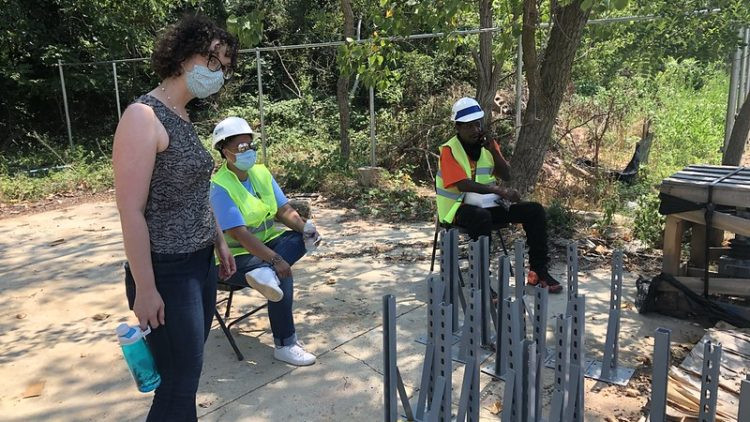This Solar For All program creates jobs and can reduce expenses for low-income households

Grid Alternatives staff install panels on a brownfield for the Community Solar at Oxon Run project, the largest renewable energy project to serve neighborhood residents in the District. Image by Grid Alternatives used with permission.
This article was originally published by Street Sense Media.
Andre Roberson has been working through the summer to install solar panels on Howard University rooftops. He gets paid $18/hour, and he was promoted in March from a team lead to a solar installer. He now manages seven or eight other workers.
The job has raised Roberson’s standard of living. “I absolutely love it,” he said. “This is the first job I’ve been in where I haven’t had any issues with management.”
Before this success, Roberson was living at the 801 East homeless shelter in DC and was unemployed. He had worked in information technology for 20 years as a network administrator but said “I just got burned out.”
With no prior solar experience, Roberson grew into his new career with the help of Solar Works DC, a low-income solar installation and job training program led by the Department of Energy & Environment (DOEE), the Department of Employment Services (DOES), and the mayor’s office. It prepares District residents to enter careers in solar and related industries and is implemented by the nonprofit GRID Alternatives, through a grant from DOEE’s Solar for All program.
“I learned something every day,” Roberson said of being trained to install solar panels. “I didn’t think at [age] 53 I could do that.” The job increased his self-esteem and confidence. He has recommended the opportunity to many of his friends who are unemployed where he lives in Ward 8. In Dec. 2019, the unemployment rate in Ward 8 was 11.4%, more than double the District-wide rate of 5.3%.
The only criteria are to be 18 years or older, be willing to get up on a roof, and have the strong desire to give back to the community through the program, according to Elijah Perry, Grid Alternative’s Mid-Atlantic’s development director.
Approximately three in 20 trainees from each cohort is homeless, though they’re not required to provide that information when applying as the program is not targeted at people experiencing homelessness, Perry said. Grid Alternatives provides each participant with education on solar installation basics, CPR and OSHA certification, and access to wrap-around services. Everyone who comes through the program meets with a case manager 1-1 who can help connect them, if needed, with food stamps, shelters, temporary housing, and other resources. It’s during these private conversations that most workers may disclose their lack of stable housing.
“How many of these trainees wouldn’t have asked for help had it not been for the program. It’s a resource within itself,” Perry said. “We want them to have these collective resources … we try to meet people where they are.”
Grid Alternatives staff working on the Community Solar at Oxon Run project. Image by Grid Alternatives used with permission.
The 12-week pipeline program aims to produce a qualified workforce for entry-level green jobs in solar and related industries. It also provided free solar installation to low-income residents in the District. The program has trained over 200 people so far, who combined have created 9,600 kW of solar capacity.
Under the mayor’s Solar for All Program implementation plan, DOEE aims to provide 100,000 low- and moderate-income homeowners access to solar power from rooftop solar panels by 2032, which is estimated to cut participants’ energy bills by 50%. If it sticks to the plan, the District is projected to reduce its “carbon footprint” to zero by 2050.
Participants could save up to $500 per year on their electricity bills, according to DOEE’s website. District residents are eligible for community solar if their household income is below 80% of the Area Median Income — $100,800 or less for a family of four and $70,550 or less for a single person. If the roofs of homes are not in good condition Solar for All contracts with a roofer, who fixes the roof, and they install the solar panels on the fixed roof, Roberson said.
By the end of this fiscal year, Sept. 30, DOEE expects to have installed solar panels on 10,000 households in DC, according to Cecile Brown, a public affairs specialist for the department, resulting in 17 megawatts of solar capacity. The program anticipates installing panels on another 3,400 houses by the end of 2020.
The program is within budget, and demand has progressed somewhat ahead of capacity. They have plenty of room to grow, Brown said. The solar development rate continues to rise within the District. The number of permits issued doubled last year from the year before.
Solar Works DC enrolls new trainees every spring, summer, and fall. Before the coronavirus pandemic, the training program included two days of hands-on solar installation experience per week, filling the other days with a mix of classes and workshops.
The program is still operating and recruiting applicants for its fall cohort. However, due to the health crisis, no installation training is taking place in the field. DOEE and DOES are making sure each trainee has a laptop and internet access, while Grid Alternatives has been implementing a 3D simulation platform for students to learn and practice installation techniques. The nonprofit’s COVID-19 task force is still developing its guidelines to safely allow trainees back in the field. For now, the full curriculum is implemented virtually.
Perry of Grid Alternatives said COVID-19 allowed the nonprofit to think more outside of the box about how to engage people who aren’t able to make it into a physical classroom and to build out a more hybrid program.
“A lot of homelessness is tied to economics and opportunity,” Perry said. “We try to create a pathway forward for people to build the life that they want and that they see themselves in.”
